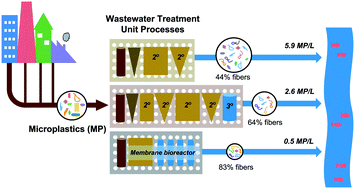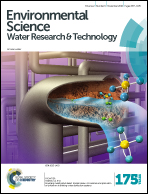Fate of microplastics and other small anthropogenic litter (SAL) in wastewater treatment plants depends on unit processes employed†
Abstract
The accumulation of microplastics (plastic particles less than 5 mm) and similarly sized small anthropogenic litter (SAL; e.g., cellulosic products manufactured from natural material) in aquatic ecosystems is a growing concern. These particles can serve as vectors of chemical toxins and microbial pathogens and thus, as organisms consume them, may lead to biomagnification of these contaminants. As collection points in managed water systems, wastewater treatment plants (WWTPs) provide an opportunity to develop and implement novel technologies to manage SAL pollution. Here, we assessed the efficiency of different unit processes at three WWTPs in removing SAL. Samples were collected from WWTPs that employ either secondary treatment (activated sludge) or tertiary treatment (granular sand filtration) as a final step, as well as a pilot membrane bioreactor system that finishes treatment with microfiltration. SAL from 20 μm to 4.75 mm was quantified and categorized by shape. The WWTP with secondary treatment removed 95.6% of SAL, discharging 5.9 SAL per L in the final effluent; the plant with tertiary treatment removed 97.2% of SAL, discharging 2.6 SAL per L; the membrane bioreactor plant removed 99.4% of SAL, discharging 0.5 SAL per L. The majority of SAL in effluent from all plants was comprised of thin fibers (e.g., textile fibers). While the WWTP with tertiary granular sand filtration and the membrane bioreactor exhibited greater overall removal of SAL, fibers represented a larger percentage of SAL in effluent from these plants (79 and 83%, respectively) than the plant with activated sludge as a final step (44% fibers). This study suggests that retrofitting existing secondary WWTPs with granular sand filtration or membrane filtration would result in the highest possible removal of SAL—though treatment facilities would continue to serve as pathways of SAL pollution to the environment. Further, the fate of the 95–99% of SAL that is retained or leaves WWTPs through means other than effluent (e.g., sludge) must be resolved to effectively address this problem.


 Please wait while we load your content...
Please wait while we load your content...